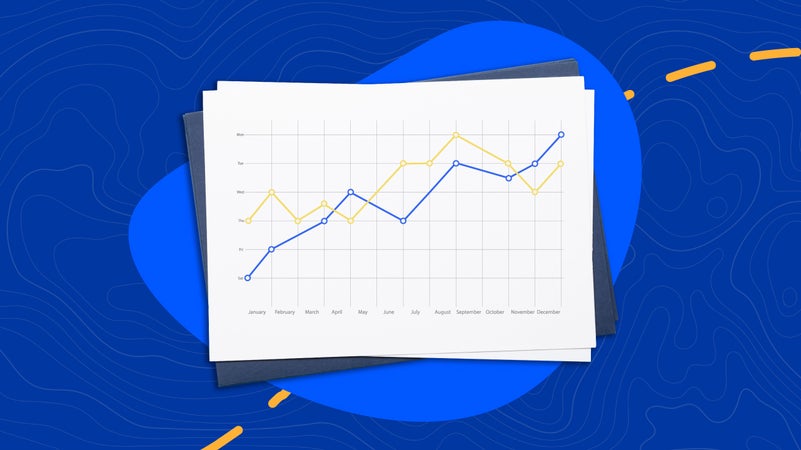How to invest in index funds

The Bankrate promise
At Bankrate we strive to help you make smarter financial decisions. While we adhere to strict , this post may contain references to products from our partners. Here's an explanation for .
Our writers and editors used an in-house natural language generation platform to assist with portions of this article, allowing them to focus on adding information that is uniquely helpful. The article was reviewed, fact-checked and edited by our editorial staff prior to publication.
Index fund investing has several benefits that make it perfect for beginners. They often charge low fees, require little maintenance and may provide built-in diversification. Plus, a simple portfolio of two to three index funds often provides enough diversification for the average investor.
These funds are typically passively managed, meaning the investments are not selected by a human fund manager. Instead, they often aim to track the performance of an index such as the S&P 500.
This is not to say index funds are without their shortfalls, of course. The biggest trade-off investors make with index funds is giving up most of the control over what is in their portfolio. Plus, they aren’t always as diverse as one might expect.
Still, for newer investors, or for those who don’t want to spend a lot of time managing their portfolios, index funds can be an excellent choice. We’ll walk you through how to buy the best index funds and reap some of the key benefits.
What is an index fund?
An index fund is a mutual fund or exchange-traded fund (ETF) that aims to match the performance of an index. Examples of these indices include the S&P 500 and the Dow Jones Industrial Average. If you invest in an S&P 500 index fund, you can expect the fund to closely mirror the performance of the index.
The S&P 500 and Dow Jones Industrial Average are examples of U.S. stock indices, but these are not the only types. There are also international stock and bond indices, among many other types. Investors often use a combination of funds that track these kinds of indices to diversify their portfolios.
If you participate in an employer-sponsored retirement fund, you may have access to index funds in the form of mutual funds. If you want to buy ETFs, though, you will likely have to invest on your own, which we’ll cover in the next section. Opening a brokerage account can offer a number of advantages, such as no investment minimums and the ability to buy fractional shares.
How to buy index funds in 3 steps
Buying index funds is a simple process. Thanks to online brokers, you don’t need much to get started, and you can get started in just a few minutes.
1. Choose a broker
Your first step is to decide where to invest your money. You can either open an account with the broker that offers the fund you want, or you can simply open an account with your preferred broker. Many of the major brokers offer their own index funds but they tend to largely track the major indices, so performance should be similar across brokers.
However, there are small differences between brokers that could impact your decision. For example, Vanguard is investor-owned, which is important to some investors. Fidelity’s website is generally considered easier to use. Others, such as TD Ameritrade, have more advanced trading tools. Thus, picking the right broker is about deciding what is most important to you.
Whatever you decide, opening an account with an online broker allows you to invest your money however you want. You will likely have access to thousands of index funds. Plus, you can usually either open a brokerage account or a retirement account, such as an individual retirement account (IRA).
2. Pick your index fund(s)
The next step is to decide which fund or funds will get your money. Some of the most popular index fund choices include:
- Large-cap U.S. stocks: Vanguard S&P 500 ETF (VOO), iShares Russell 1000 ETF (IWB), Invesco QQQ Trust (QQQ)
- Small-cap U.S. stocks: iShares Core S&P Small-Cap ETF (IJR), iShares Russell 2000 ETF (IWM)
- U.S. total stock market: Vanguard Total Stock Market Index (VTSAX), Schwab Total Stock Market (SWTSX), iShares Russell 3000 ETF (IWV)
- Total international stock market: Fidelity International Index Fund (FSPSX), Schwab International Index Fund (SWISX)
- Total U.S. bond market: Fidelity U.S. Bond Index (FXNAX), Vanguard Total Bond Market Index (VBTLX)
- Total international bond market: SPDR Bloomberg International Treasury Bond ETF (BWX), Invesco International Corporate Bond ETF (PICB)
Most savvy investors would likely avoid investing in both the S&P 500 and U.S. Total Stock Market funds because the latter includes the former. The S&P 500 comprises about 500 of the largest publicly traded companies in the U.S., while a total stock market index tracks all U.S. publicly traded companies.
Beyond this, the way you allocate your money is a personal choice.
3. Buy shares of an index fund
Once you have picked your broker and chosen your fund(s), the hard work is done: all you have left to do is buy your shares. However, if you decide to invest in multiple funds, you still have to decide how much to invest in each fund type.
In general, younger investors planning for retirement should consider putting a larger allocation of their portfolio in higher-risk investments, such as stocks, since they have more time on their side before needing the money. The closer someone is to retirement, though, the more they may want to consider shifting a larger chunk of their holdings into bonds or other lower-risk assets since they are less likely to lose value in the short term.
Advantages and disadvantages of index funds
Index funds are ideal for new investors, but they have their fair share of advantages and disadvantages.
Advantages of index funds
- Low fees. Index funds simply track an index; they are not actively managed. This allows fees to stay low, with some index funds charging no fees at all.
- Built-in diversification. Index funds that track a broad index are inherently diverse. For instance, an S&P 500 fund allows you to own a small piece of about 500 of the largest companies in the U.S. across different industries. Thus, these funds provide instant diversification.
- Minimal maintenance. When you buy index funds, rebalancing your portfolio may be less needed. If you were to put all of your money in a single index fund (not necessarily recommended), the fund itself handles all of the shifting allocations for the constituents in the index.
- Tax efficiency. Because index funds are not actively managed, they buy and sell stocks infrequently. This helps reduce capital gains taxes you might otherwise incur.
Disadvantages of index funds
- No ability to select stocks in the index. For beginners, it can be nice having everything done for you. But more advanced investors often prefer to hand-select their stocks — something that isn’t possible with index funds.
- Can be less diverse than expected. Index funds are often market-cap-weighted, meaning they invest more of their money in companies with higher market caps. So larger companies make up a bigger share of a given index.
Bottom line
There’s a lot to like about index funds, including low fees, low maintenance and built-in diversification. It’s easy to start investing with an online broker, and you only need a handful of funds to start a portfolio. Index fund investing is one of the simplest ways to get your money in the market. They might not be as sexy or exciting as day trading stocks, but as legendary investor Warren Buffet says, “Index investing is the way to go for most people.”
Editorial Disclaimer: All investors are advised to conduct their own independent research into investment strategies before making an investment decision. In addition, investors are advised that past investment product performance is no guarantee of future price appreciation.


